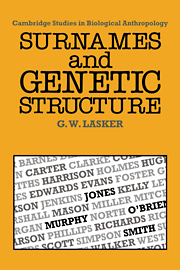Book contents
- Frontmatter
- Contents
- Preface
- 1 Introduction
- 2 History of surname studies in human biology
- 3 Sources of data
- 4 Methods
- 5 Isolates and inbreeding
- 6 Island versus distance models: the Far East and Oceania
- 7 The Americas and continental Europe
- 8 Scotland and Ireland
- 9 Regions of England
- 10 English cities and the general population of England and Wales
- 11 Specific surnames in Great Britain
- 12 Human population structure
- Literature cited
- Appendix maps and diagrams, of the distribution of 100 surnames in England and Wales
- Glossary
- Index
10 - English cities and the general population of England and Wales
Published online by Cambridge University Press: 05 November 2011
- Frontmatter
- Contents
- Preface
- 1 Introduction
- 2 History of surname studies in human biology
- 3 Sources of data
- 4 Methods
- 5 Isolates and inbreeding
- 6 Island versus distance models: the Far East and Oceania
- 7 The Americas and continental Europe
- 8 Scotland and Ireland
- 9 Regions of England
- 10 English cities and the general population of England and Wales
- 11 Specific surnames in Great Britain
- 12 Human population structure
- Literature cited
- Appendix maps and diagrams, of the distribution of 100 surnames in England and Wales
- Glossary
- Index
Summary
Coleman (1979, 1980a, 1982) has done a great deal to shed light on the population structure and marriage pattern of a modern English city and its environs. Most of the population of England is in urban areas, but almost all the other studies of population structure have been of villages. Coleman analysed the pattern in Reading, Berkshire, and its environs by a study of all the marriage records for a 12-month period in 1972–3, using copies of the registration records in the districts of Reading, Wokingham and Henley-on-Thames. A questionnaire seeking much additional information was circulated to a sample and returns were received from 946 of the 2396 couples married during the specified period. The average couple had been born 103 kilometres from each other – about the same distance as their parents. The average distance from their place of residence when single to the place where they met their future spouses was small, however, compared with the mean distance from the meeting place to the place where the couple resided after marriage. Thus migration after, or at the time of, marriage was an important element in inter-generational migration. As Coleman puts it, the people become individually more heterogeneous but collectively more homogeneous with regard to ancestry (and hence genetic constitution). There is enough migration that in only three generations the population of the built-up area of Reading would be 95% homogeneous.
- Type
- Chapter
- Information
- Surnames and Genetic Structure , pp. 62 - 65Publisher: Cambridge University PressPrint publication year: 1985



